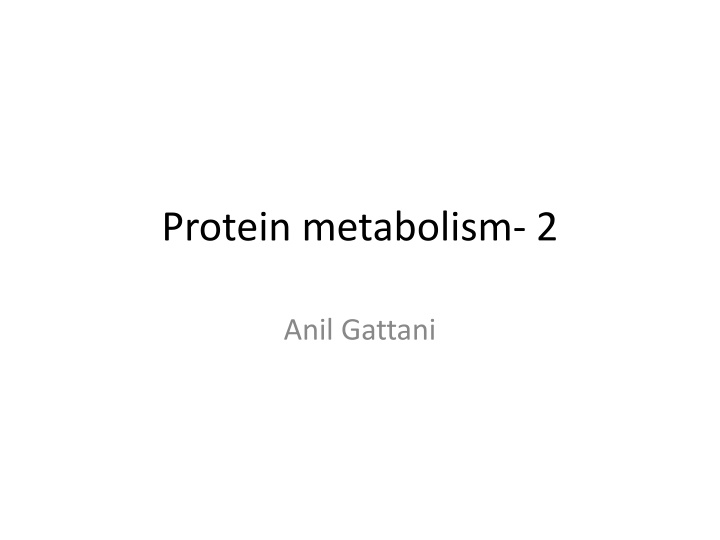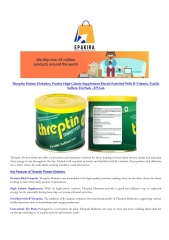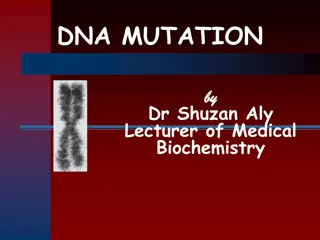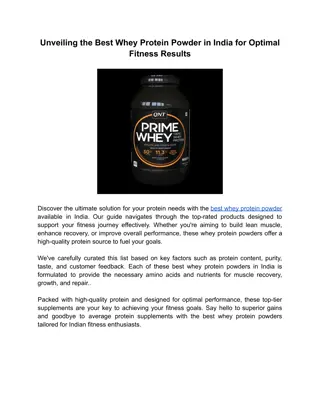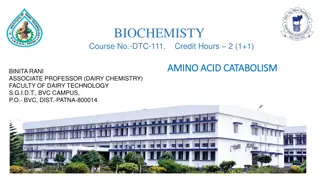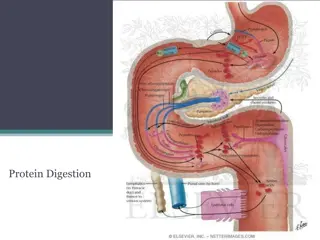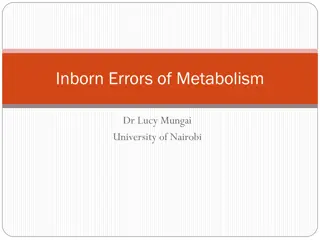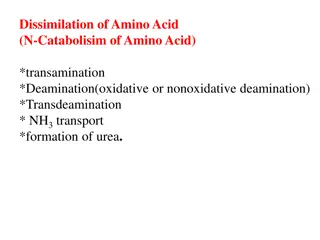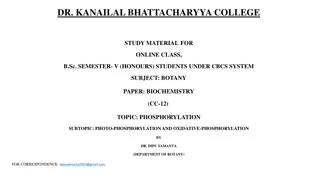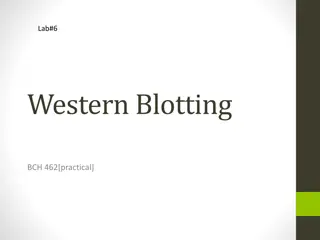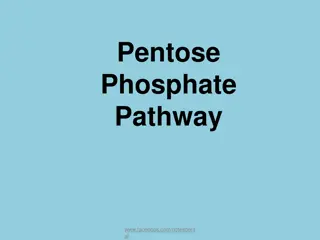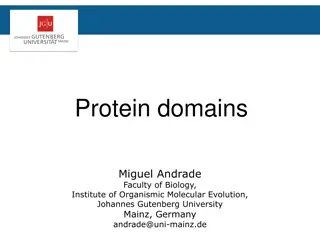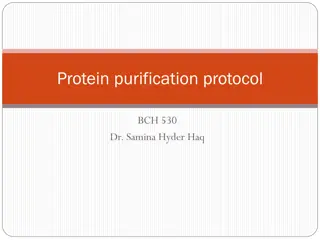Protein Metabolism: Oxidative and Non-Oxidative Deamination Process
Explore the intricate mechanisms of oxidative and non-oxidative deamination in protein metabolism. Learn how amino acids are metabolized, the role of enzymes like Glutamate Dehydrogenase, and the excretory forms of nitrogen. Discover the impact on brain function, neurotransmitter levels, and potential consequences of disruptions in these processes. Dive into the summary of amino acid catabolism and the complexities of nitrogen transport.
Download Presentation

Please find below an Image/Link to download the presentation.
The content on the website is provided AS IS for your information and personal use only. It may not be sold, licensed, or shared on other websites without obtaining consent from the author.If you encounter any issues during the download, it is possible that the publisher has removed the file from their server.
You are allowed to download the files provided on this website for personal or commercial use, subject to the condition that they are used lawfully. All files are the property of their respective owners.
The content on the website is provided AS IS for your information and personal use only. It may not be sold, licensed, or shared on other websites without obtaining consent from the author.
E N D
Presentation Transcript
Protein metabolism- 2 Anil Gattani
Oxidative Deamination Oxidative deamination Removes the amino group as an ammonium ion from glutamate. Provides -ketoglutarate for transamination. Mainly in liver and kidney
Oxidative Deamination L-AA oxidase and D-AA oxidase act on L-AA and D-AA respectively and oxidatively removes NH3 from AA. Glutamate formed by transamination reactions is deaminated to -ketoglutarate Glutamate dehydrogenase - NAD+or NADP+is coenzyme Other AA oxidases - (liver, kidney) low activity
+ NH3 H2 C H2 C OOC glutamate COO C Glutamate Dehydrogenase catalyzes a major reaction that effects net removal of N from the amino acid pool. H NAD(P)+ NAD(P)H H2O O H2 C H2 C OOC -ketoglutarate COO + C + NH4 Glutamate Dehydrogenase It is one of the few enzymes that can use NAD+ or NADP+ as e acceptor. Oxidation at the -carbon is followed by hydrolysis, releasing NH4+.
Non Oxidative Deamination A. Amino acid dehydratase- act on hydroxy AA (serine, threonine) require pyridoxal phosphate B. Histidase- on Histidine to NH3 and urocanic acid C. Desulfhydratase- on Sulphur containing AA
+ Amino acid -ketoglutarate NADH + NH4 -keto acid glutamate NAD+ + H2O Transaminase Glutamate Dehydrogenase Summarized above: The role of transaminases in funneling amino N to glutamate, which is deaminated via Glutamate Dehydrogenase, producing NH4+.
Excretory Forms of Nitrogen
Summary of Amino Acid Catabolism
NH3 Trasport NH3 is toxic and should be remove Enhance amination of alpha ketogluterate to glutamate in brain leads to decreased TCA Enhance glutamine formation from glutamate leads to decreased formation of GABA Increased outflow of glutamine leads to increased entry of tryptophan result into increased serotonine concentration Glutamine is osmotically active results cerebral edema
Substrates for the Urea Cycle + -amino acid -ketoglutarate H2N-CO-OPO32- NADH + NAD+ + -keto acid glutamate Above, amino groups are transferred to glutamate, from which ammonium is produced, and then used to make carbamoyl phosphate. Below, amino groups are transferred to produce aspartate. aspartate -amino acid -ketoglutarate -keto acid glutamate oxaloacetate
Urea Cycle Aspartate and carbamoyl phosphate each deliver an amino group to the cycle. The carbamoyl phosphate production and condensation occur in the mitochondrial matrix. Fig. 23.16
NH4+ from Oxidative Deamination of Glutamate O O O O NAD+ NADH + H+ + NH3 H O NH4+ + CH2 CH2 CH2 CH2 glutamate dehydrogenase O O O O glutamate -ketoglutarate Hexameric glutamate dehydrogenase is controlled allosterically. High energy levels inhibit (ATP and GTP). Low energy levels activate (ADP and GDP). NADP+ can replace NAD+. NH4+ , which is toxic, is produced in the mitochondria and used to make carbamoyl phosphate.
Carbamoyl Phosphate Synthesis (p. 645) Carbamoyl phosphate synthetase is in mitochondrial matrix. NH4+ is source of NH3. The hydrolysis of two ATP make this reaction essentially irreversible. N-acetyl glutamate is an allosteric activator.
O NH2 H O N O H Pi + + O CH2 O H3 N O CH2 O P H2N + CH2 ATP CH2 O + H NH3 carbamoyl phosphate O O aspartate O O citrulline 1 4 O + O H NH3 + H2 N UREA CYCLE (1-3 in cytosol, 4 in mitochondial matrix) CH2 N H H + AMP + PPi N CH2 CH2 ornithine CH2 CH2 CH2 + O O 2 Pi H NH3 CH2 O O + H NH3 2 ~ P used O O + H2 N 3 argininosuccinate 2 NH2 H H2 N N CH2 NH2 O O CH2 H O UREA CH2 + H2O H NH3 H O fumarate O O O arginine 1. ARGININOSUCCINATE SYNTHASE 2. ARGININOSUCCINASE 3. ARGINASE 4. ORNITHINE TRANSCARBAMOYLASE
Connection to Krebs Cycle -keto acid + aspartate ATP citrulline -amino acid 1 UREA CYCLE Oxaloacetate argininosuccinate NADH + AMP + PPi 2 Pi 2 NAD+ Malate arginine fumarate H20 Fumarate is oxidized to oxaloacetate by Krebs cycle enzymes, producing NADH. Oxaloacetate accepts an amino group instead of being condensed with acetyl CoA.
amino acid -keto acid -ketoglutate Amino Acids to Urea * NH4++ CO2 + 2 ATP + H2O glutamate -keto acid 2 ADP + Pi + H+ + carbamoyl phosphate + ATP aspartate citrulline amino acid ornithine UREA CYCLE Oxaloacetate argininosuccinate + AMP + PPi H2 N 2 Pi NH2 O Malate arginine UREA H2O fumarate *Glutamate Dehydrogenase is the control site: ADP (+), GDP (+), ATP (-), GTP (-) and NADH (-). Control at other sites by glucagon (+), cortisol (+), insulin (-), growth hormone (-).
Low dietary protein reduces need for urea cycle. Argininosuccinase Deficiency O High dietary arginine provides a path for carbamoyl phosphate and aspartate nitrogens to produce argininosuccinate, which is excreted. NH2 H O N O H + O CH2 O H3 N + O CH2 ATP O P H2N CH2 CH2 O carbamoyl phosphate + H NH3 O O O aspartate O 1 citrulline 4 O + O H NH3 + H2 N CH2 N H H + AMP + PPi UREA CYCLE N CH2 ornithine CH2 CH2 CH2 CH2 + O O 2 Pi H NH3 CH2 + O O + H H2 N NH3 O O NH2 H argininosuccinate (excreted) N 3 2 CH2 H2 N NH2 CH2 O O H O UREA CH2 H2O + H H NH3 O fumarate O O O arginine (excess supplied)
Carbamoyl Phosphate Synthetase Deficiency Fig. 23.20 Hippurate and phenylacetylglutamine are excreted. Amino groups to glycine and glutamine by transamination.
